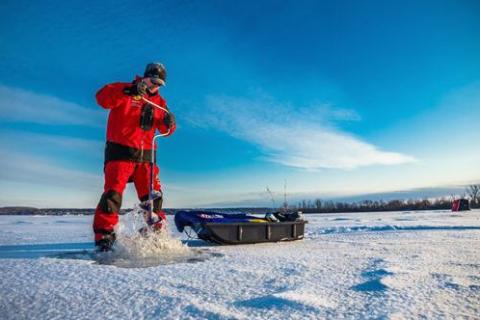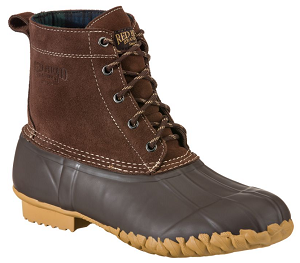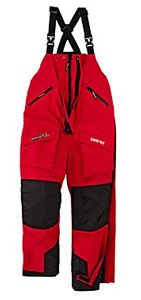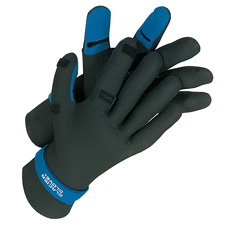
The time between the first snowfall and the first good ice is never long enough for sportsmen who transition from late-season hunting to ice fishing. It seems you barely have time to put away your rifle before hearing reports of fish being pulled through the ice.
Since ice fishing is one of those special sports where preparation is everything, hav

cover your feet when drilling your fishing
holes, a good pair of boots has to be
waterproof like the RedHead All-Season
Classic II Lace-Up Insulated Waterproof
Boots for Men (Click photo above to
view).
ing the right clothes for the early season can mean the difference between coming home with your limit and aborting your trip without a single catch because you weren't prepared for the cold. The following guide on dressing for the ice should help you prevent the latter from happening.
Cold-Weather Socks and Footwear
Probably the most important item for ice fishing is a quality pair of cold-weather boots. Many boots you find in stores will keep your feet warm while walking around, but a quality pair of ice boots will keep your feet dry and warm all day.
Because lake water, slush and snow will cover your feet when drilling your fishing holes, a good pair of boots has to be waterproof like the RedHead All-Season Classic II Lace-Up Insulated Waterproof Boots for Men from Bass Pro Shops. Additionally, a good pair of boots will have removable liners that can be taken out and dried after a hard days fishing. Boot ratings need to be considered when buying ice fishing boots. The rating will tell you the conditions that the individual boot can be worn comfortably in.
Socks are another key consideration for serious ice fisherman. Socks are the last line of defence when it comes to keeping your toes from freezing. Having one pair of heavy duty wool socks is great to insulate your feet from the cold, but having a second pair of wicking socks are key to keeping your feet dry. Wicking socks are great for ice fisherman because they pull perspiration that builds around the feet away from the skin. There are lots of good quality socks on the market, some made specifically for winter sports. Don't skip when you are looking to purchase socks. A good pair will last you a long time and will keep your feet much warmer.
Lastly, a pair of cleats or traction devices that slip over your boots might be necessary, depending on where you plan to fish. If the conditions are very icy and you are having a trouble keeping your balance, a good pair of ice cleats will make manoeuvring much easier. Cleats are a great idea if you plan on dragging a sled with your gear when there is not a whole lot of snow. It can be a real challenge to get a good enough grip on the ice without cleats to move a 70- to 90- pound gear packed sled.
Smart Layering Helps Ice Fishing Anglers Adjust to Temperatures
 |
| GORE-TEX outerwear such as these rain bibs will help keep wind, rain, sleet and snow away from the body. |
Layering is the key to keeping the body's core warm. Layering allows ice fishing anglers to strip down should the body become too warm, either from excessive work or the heat of the sun's rays. The secret to layering is to have enough clothes on to handle even the worst conditions and slowly remove them one piece at a time should it become too warm. Also, when layering, try creating at least one one-piece layer. The advantage to a single piece component is that there is no point where warmth can escape, keeping the body warmer longer. As for the torso and legs, these body parts never get directly exposed to the cold weather, so having clothes that hold heat in and move water out is essential.
Over the past 10 years, winter jackets have probably evolved as much as any other piece of equipment, if not more. New space-age fabrics such as Gore-Tex and Supplex are phenomenal at keeping the wind, snow and sleet away from the body while still allowing the body to breathe. Good coats will incorporate these types of fabrics along with waist and wrist cuffs to stop the cold weather from sneaking in. Purchasing a coat with a removable liner is another great idea since all days are not created equal; what you wear for zero degree weather is not what you want to be wearing when the temperature is in the teens.
Sweaters and shirts made of wool and fleece are great for under layers. These fabrics can keep the body as warm as anything else on the market. One or two layers of these fabrics will keep heat in for hours on end. A good idea similar to that of the socks idea is to have a fabric against the body that is a wicking layer to pull any perspiration away from the body.
For the legs, traditional long underwear is a good place to start with a second layer of fleece or wool leggings pulled over top. If you do not have one of these types of secondary underwear, then a pair of sweatpants pulled over the long underwear will suffice, but will probably be a little cumbersome to move around in.
To cover up the legs, a pair of waterproof coveralls is a must. When ice fishing, you're constantly on your knees tending to lines, so a pair of bibs that keep your legs dry are worth their weight in gold.
Floating Ice Angler's Suit
Of all the great new ideas to make your time out on the ice more safe, the floating ice angler's suit has be on the top of the list. Not only do these suits boast good insulation and wind stopping ability, they also have incorporated floatable materials into their respected design. If you are unlucky enough to fall though the ice, these suits will keep you floating on the surface until help comes or you can find a way out. These suits certainly don't take the place of always using good precautions when venturing out on a new lake but can definitely help put your mind at ease that if fishing with a buddy you have a great shot at getting out of that sticky situation.
Warm Gloves and Hats for Ice Fishing
 |
| Neoprene gloves, like the Glacier Glove Fleece-Lined Neoprene Gloves, protect your hands from ice-cold water. |
Distal extremities are some of the more critical body parts to protect when ice fishing. Fingers are usually the first part of the body to feel the cold weather, and even the simplest of tasks can become a challenge with cold hands. Good gloves and mitts are a necessity, and, depending upon the conditions, both may be necessary. Having a second pair of gloves is a good idea since everything you do while ice fishing will get your hands wet.
Neoprene gloves such as the Glacier Glove Fleece-Lined Neoprene are a good idea because they protect your hands from the icy cold waters; however, they don't offer too many advantages in overall warmth. If you are the type that cannot resist sticking your hands down the hole to grab fish, they do make neoprene gloves that almost reach your elbows. These gloves are great at protecting you while in the water but will freeze once get exposed to the cold air conditions.
A stocking cap or toque is another key piece of ice-fishing attire. The body loses a major percentage of its heat through the head, so having a good hat that prevents heat loss is a must. Fleece lined caps feel great and will do a great job keeping you warm.
Sunglasses to See Fish Strike or Tip-ups Going Off
When you are out on the lake, snow cover will reflect the sun's rays, making it extremely bright and unbearable for your eyes. A good pair of sunglasses will protect your eyes from the sun's dangerous UVA and UVB rays, while at the same time making it easier to see delicate strikes or tip-ups going off, especially if they are any distance away.
There's nothing worse than getting to your favorite ice fishing spot, dropping your lines into the water, and then having to leave early simply because you can't stand the cold. With a little planning and attention to what you're putting on, anglers can protect against almost any foul weather conditions they might encounter. With ice fishing, half the battle is staying warm long enough to stay on the ice and catch fish. Catching the fish, on the other hand — that's a topic for another article.
- 35263 views

